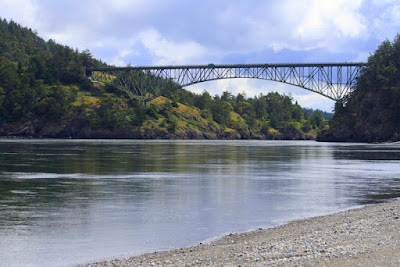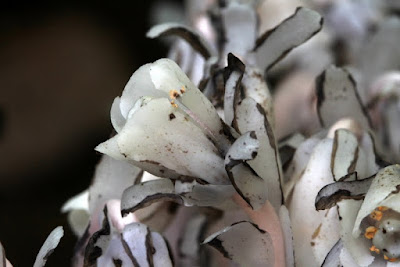Monday, August 13th, was the first day of the Northwest Washington Fair, held here in our town, and a good day to be out of town. My wife was babysitting the children of a friend who was working at the fair, and so I made the day's excursion on my own.
I went first to Larrabee State Park south of Bellingham in the Chuckanut Mountains and walked the Clayton Beach trail looking for the Broad-leaved Helleborine (Epipactis helleborine) which grows there along the railroad tracks that run through the park
This orchid is interesting in that it is not native to the United States or Canada but has established itself across the northern USA and southern Canada. I've seen it on the east coast and in the sand dunes in western Michigan along Lake Michgan.
In Larrabee it would appear that the orchid has been distributed by the railway since it grows in the brush along the tracks and along the trail leading from the tracks. How it could have been distributed by rail, I have no idea, but that is the only place it can be found.
I found both a very pale pink and green and a dark purple version, though the darker flowers were all past their prime. There were also some, not yet open, that had no hint of coloring at all and I would like to check them later to see if they are the alba variety.
Some of the plants were short, less than 30 cm but others were quite tall, up to 120 cm. Most were single stems though the plant can form large clumps. I spent several hours photographing them before continuing to the beach where I took more photos, including some of a dead shark.
I also spent some time taking pictures of the Madrona trees (Arbutusa menziesii). I am fascinated by their peeling bark (this is normal), colorful wood, and beautiful forms. This tree is native to the west coast from British Columbia to Mexico, primarily in the northern parts of this area.
Leaving Clayton beach, I headed back north to Deception Pass, the narrow strait that separates Whidbey Island from Fidalgo Island and which is crossed by a high bridge. Parking at the pass I hiked to the top of Goose Rock at the northern end of Whidbey Island.
Goose Rock is a wonderful place for native wildflowers and orchids with its granite balds, areas of exposed rock that support a unique and wonderful flora. It is 484 feet and provides great view of the Straits of San Juan de Fuca, of the San Juan Islands, and of the Cascades.
The hike to the top is less than a mile but steep. I found three native orchids, the Long-Spurred and Flat-spurred Piperias (only a few of the former) and huge clumps of the Giant Rattlesnake Orchis, a plant so common in this area that I usually do not bother to take pictures.
Long-spurred Piperia
Flat-spurred Piperia
Giant Rattlesnake Orchis
I also found a lot of Indian Pipes, a ghostly white saprophyte that grows on the forest floors, in one case the largest clump of these I had ever seen, and a very unusual fungus or mushroom that looked a bit like bakery rolls. Finished, I headed back home and back to work.































8 comments:
I spent some time yesterday in Kauai trying to buy a spray of orchids at the farmer's market but I was too late. They usually sell out pretty fast. I really marvel at the beautiful orchids you find and am so glad you share these images on your blog. I didn't realize the madrona trees were native to the west coat. I've always thought they were beautiful and just assumed they were something exotic that was transplanted into my West Seattle neighborhood.
They are exotic but only in being so unusual, not because they are from some distant tropical area. We have so much beauty here, that I wish I had another lifetime to explore it all.
What a gorgeous post Ron!
I love that tree with the Hydra head of curls in wood (just before the orchids stampede through the alley of your post).
The idea of those orchids following the railway is so cute. I will think of them as pioneer orchids.
I am addicted to odd scenes on hikes and I find your defoliating Madrona tree pictures to be very attractive. If you weren't around to post these photographs I'd never learn all these odd matters of the world. I just have stunted aspens, big palmed poplars, hairy firs and a few elm trees (at the University area) to gawk at in Edmonton.
This paucity of tree variation is why I stuff as many different kinds of trees as I can onto tiny lots wherever we live....because I am hungry for such variety that you have an excess of. Only problem is they don't want to grow --my Catalpa tree is the same size as when I bought her five years ago and my Ginkgo tree is pouting on the front garden bed. The Ohio Buckeye isn't as large as I'd hoped he'd be by this time and every hail storm stunts him a tad more.
I love mushrooms as well for their rubbery lips, their big hips, and their tiny waists so any mushrooms you find, please put up for deviants like myself.
The Indian pipes are the oddest things I have ever seen (more odd than the Progressive Conservative politicians in Alberta).
You are just amazing in terms of your eye (the third eye in the middle of your soul).
Too bad your wife was left with the friend's babies.
She could have added some of her photos here.
Julie
How I wish I could write like you do, Julie. Your description of mushrooms is exquisite and your comments about the Alberta politicians is hilarious, though I am sure it also has an edge to it. We, too, seem to be attracted to the odd and unusual and the Indian Pipes are about as unusual as things get. My next post, Poodle Dog Pass (I'll try to get it up later today or tomorrow) will have more fungi (taken by my wife).
Awesome orchids and Indian Pipes =)
~Fizzie~
Thanks, my friend. Appreciate your checking out this post.
Growing up we would go to the log landings a drag the Madrona out and cut it up for firewood, it made a nice hot fire and burned with some of the cleanest ash. As an adult I have collected branches from the tree to use in my terrariums for my snakes to crawl about on. Guess there are other uses for it but most is cut during logging operations and is pulled up into slashing piles to be burnt.
Now days the logging companies have gated off a large portion of the timber lands that I used to hike in, take nature photos or where I would ride my bike. WeyCo is the largest timber holder in the state and they require a pass to enter their lands, it is rather expensive, somewhere in the neighborhood of $600+ the last I heard.
Richelle A Kemnow, LPN (ret)
Thanks, Richelle. We've found, too, that far to many areas are closed to hikers and the clear tactics of the logging companies are hateful. The Madronas are more and more threatened all through their range and the practices of the logging companies are to be abhorred for that reason also.
Post a Comment